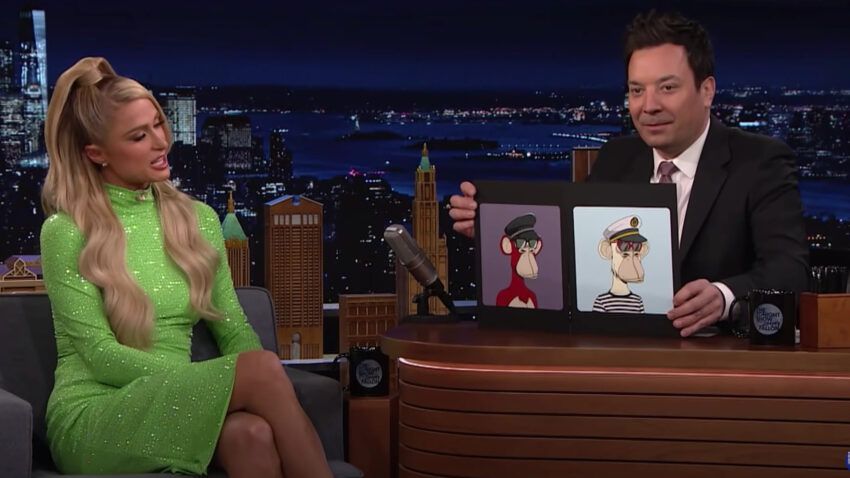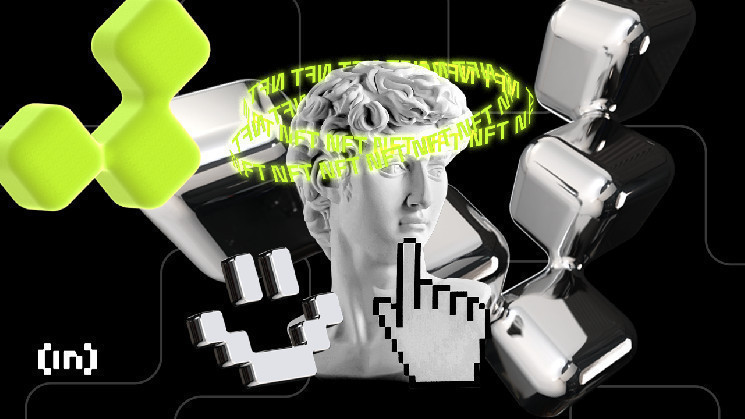Ask anyone on the street about NFTs in 2023, and you will likely get a grimace. Or some kind of disapproval. With the NFT “brand” so soaked in cringe, who can blame them?
If there ever was a single moment when NFTs became “cringe,” there’s a good case to be made that it happened during Paris Hilton’s appearance on The Tonight Show Starring Jimmy Fallon.
It was one year ago this week that the two celebrities met to show off their NFTs. Both Hilton and Fallon had purchased “Bored Apes” from the Bored Ape Yacht Club (BAYC) NFT collection. A project that—even then—was synonymous with “expensive JPEGs.”
“The last time you were on the show, I asked you to explain NFTs,” said Fallon, with his usual plastic charm. “And you did so in a great way.” As a gracious host, Fallon then namedropped Hilton as one of Forbes Top 50 Most Influential People In NFTs. The socialite replied with among the most banal series of words ever strung together.

“Thank you, I’m so proud. I love being part of this community, and being a voice and sharing my platform, and just getting the word out there. Because I think it’s just such an incredible thing.”
The damning coverage was impossible to ignore: Forbes, The Atlantic, The Telegraph, VICE, The Cut. Whether you had written about NFTs before or not, it didn’t matter. This was public interest journalism; two rich people talking about their exorbitant monkeys. It was funny, it was cringe, it was a lot of things. (According to reports, of course.)
Was Jimmy Fallon Peak Cringe?
People who knew my job would inevitably ask about that moment. (At the time, I was working in Web3 PR.) “Have you seen Paris Hilton and talking about her silly monkey,” a friend would say. Well, yes, I would reply. After all, that is my industry. Straining every sinew in my body to hide the shame. This is not what NFTs were supposed to be. It is not what NFTs are. But try telling that to someone whose first interaction with space is via a million-dollar picture of a monkey.
As one industry veteran put it to me: “Nearly every publicly known BAYC holder are the exact type of people you don’t want to be at a party with. (Except Paris Hilton, she’s a doll.) The entire brand and vibe is ick to me — the exact opposite of what Web3 and the vision of decentralization is supposed to be about. Not here for helping rich people get richer.’
That same month, reports of Justin Bieber paying $1.3 million for a BAYC NFT only heightened the animosity. By the spring of last year, the celebrity roster of the Bored Ape Yacht Club was a wall-to-wall of household names. Madonna, Post Malone, Tom Brady, Snoop Dogg, Eminem, Logan Paul, Timbaland, Mark Cuban. One analysis showed this feeling was based on fact. Of all the thousands of NFT collections, BAYC was the celebrity favorite. No surprises there.
Although, despite cries of “cringe” from the cheap seats, perhaps Yuga Labs (the creators of BAYC) were on to something. Hilton’s appearance on Fallon’s show coincided with a surge in the BAYC floor price. (The “floor price” is the minimum price at which an NFT can be sold.) The floor price on the day of the show was 90 ETH, but it went on to spike to 118 ETH on Feb 1. (So, at the time, approximately $329,470 dollars.) If you listen closely, you can hear them laughing.
Although, higher prices do not necessarily mean people thought of BAYC as less cringe. An appearance on one of America’s most popular talk shows is a bullish signal. This a sign that BAYC is in demand, precipitating a rise in value. If you’re trading NFTs for profit (which most do), your wallet doesn’t care how cringe the rich and famous are.
Bored Apes And The Damage To The NFT Brand
Nevertheless, extensive media coverage of celebrities and their Bored Apes apparently did little for the wider NFT brand. A February 2022 survey of UK residents conducted by YouGov showed that 43% of respondents would feel less favorable if a company began offering NFTs. Only 3% of respondents would feel more favorable.
There is also a stark difference in their perceived value depending on whether you own one or not. According to a survey by Variety Magazine, consumer perceptions of non-fungible tokens (NFTs) have declined, especially among those who haven’t bought them. Most non-owners believe that NFTs are a poor investment, with just 15% believing they make a good one. In contrast, those who own one have a very different view. Two-thirds believe it’s a good investment, and just 5% think it’s a poor one. Again, no surprises there.
To anyone paying attention, it was obvious when the hype disappeared. The discussion of “blue chip” NFTs (like BAYC) suddenly plummeted as we entered the second half of the year. Around the same time, sales fell off a cliff too. The talk of “community” that accompanied the hype mostly vanished into thin air. Notes of optimism mainly came from BAYC holders and NFT die-hards.
The power of cringe has meant even bullish companies like Reddit have moved away from the term NFT, instead opting for the term ‘Collectible Avatars.’
One of the few spikes in interest in the second half of the year came in November when news broke that Justin Bieber’s $1.3 million Bored Ape had fallen in value by 94%. After all, there is nothing quite like schadenfreude.
 beincrypto.com
beincrypto.com
